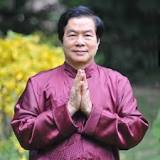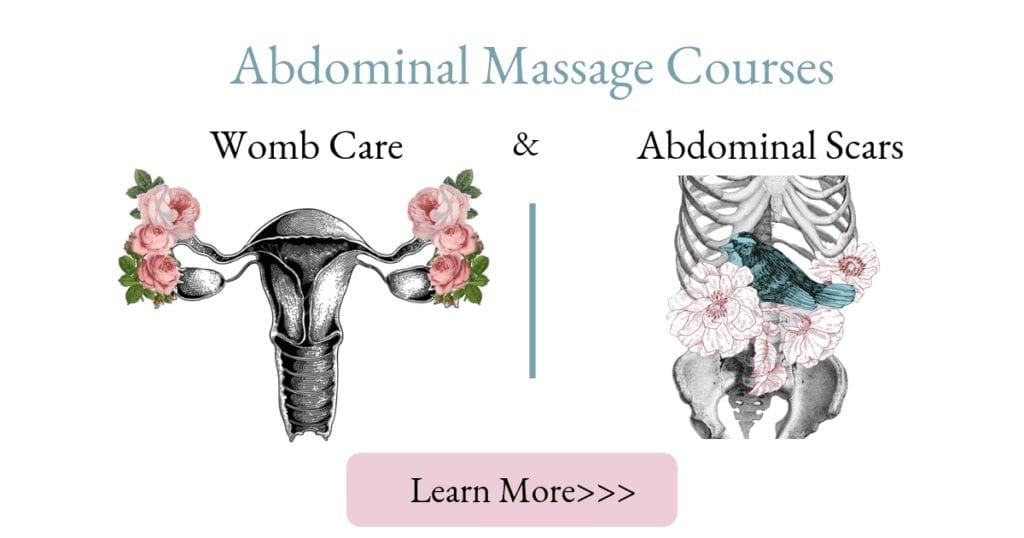I receive emails and phone calls weekly from bodyworkers who are interested in learning abdominal therapy. They ask me which modality they should focus on. That’s a tough question to answer because it really depends on the individual, their commitment level, and how they approach the body. So, I’ve outlined three different forms of abdominal therapy that I’ve trained in. I’ve also included a general layout of each of the educational paths. The best way to really know which modality to study is to receive treatments and see which one resonates with you.
The abdominal treatments I offer are influenced by many modalities (not just the abdominal therapies listed here). I’m guided by the individual person, not a particular protocol. So, the treatments I offer and teach morph into something entirely different from one treatment to the next.
Massage therapists can earn 14 continuing education credits for completing both the online Free The Belly Abdominal Scars & Restrictions course & the Womb Care course. These self-care courses are approved by NCBTMB for home-study continuing education credits.
Visceral Manipulation™
was developed by world-renowned French Osteopath Jean-Pierre Barral. VM assists functional and structural imbalances throughout the body including musculoskeletal, vascular, nervous, urogenital, respiratory, digestive and lymphatic dysfunction. It evaluates and treats the dynamics of motion and suspension in relation to organs, membranes, fascia and ligaments. VM aims to increase proprioceptive communication within the body, thereby addressing symptoms of pain, dysfunction, and poor alignment. VM is a low force way of working with the bodies own intelligence. Visceral Manipulation™ is VERY specific in its evaluation and treatment. For example, we don’t just treat the uterus in general, we’re pinpointing where the exact restriction is. For instance, I may be specifically working with the right uterosacral ligament or perhaps the left round ligament, etc. Or in the case of the liver, I may be working to release restriction at the left triangular ligament or falciform ligament. Visceral Manipulation™ is the most specific approach out of any modality I’ve been trained in. Visceral Manipulation™ doesn’t have a self-care component because it’s too difficult to do on oneself. Although, it does work with the bodies innate healing capacity and intelligence. In fact, we space treatments out 2-3 weeks in order to allow the body to self-correct. Another interesting thing about the VM approach is that I may work with the liver (or other structure) to address bladder issues. Everything is connected! The body will let me know where to work. You should also know that if you are a bodyworker and want to specialize in reproductive organs, you must first take VM1 and VM2 before taking VM3 (the pelvis).

Jean-Pierre Barral
Arvigo Techniques of Maya Abdominal Therapy®

Dr. Rosita Arvigo and Don Elijio Panti
Dr. Rosita Arvigo, DN developed these techniques, after apprenticing with Don Elijio Panti, the last of the Traditional Maya Shaman in Central America, where she has lived for over 30 years. The Arvigo Techniques of Maya Abdominal Therapy® combine modern science with traditional healing and wisdom to produce a holistic path to physical, emotional and spiritual wellbeing. The Arvigo Techniques of Maya Abdominal Therapy® (ATMAT) may incorporate massage, herbs, nutrition, meditation and emotional/spiritual healing into a holistic approach for wellness depending on the Arvigo Practitioner you work with. But, the Arvigo work will always include abdominal massage from the pubic bone to the ribcage and posterior work as well. The massage is a non-invasive, external massage. It is our experience that these techniques support digestive and reproductive health by restoring circulation and energy flow as well as reducing congestion and inflammation of the abdomen. The Arvigo Therapy® also incorporates massage and manual therapy along the sacrum, coccyx, lumbar and thoracic areas of the body and should include the teaching of abdominal self-care massage. The Arvigo techniques are known mostly for repositioning the uterus to its ideal position, but it also benefits women who have had hysterectomies and men by enhancing blood and lymph flow and nerve conduction. As with the Chi Nei Tsang, the Arvigo® work does include a self-care component.

Me and Dr. Rosita Arvigo under the full moon in Belize.
Chi Nei Tsang

Kyle Cline

Master Mantak Chia
Training
Visceral Manipulation™
The training for Visceral Manipulation™ is comprehensive and very specific. It’s recommended to retake classes and join study groups to refine your skills because it takes a lot of practice. Knowing your anatomy is crucial! The best teachers I know never stop learning. As a Visceral Manipulation™ practitioner, I’m constantly studying anatomy and refining my skills. Here is a brief outline of Visceral Manipulation™ courses. Please check out the official Barral Institute website for a complete and up to date list.
- L1- Osteopathic manual evaluation techniques
- L2- An Integrative Approach To Evaluation
- VM1-Abdomen Liver, Stomach, Intestines
- VM2- Spleen, Kidneys
- VM3- Pelvic Organs
- VM4- Thorax
- VM5- Manual Thermal Evaluation
- VM6-VisceroEmotional Relationships
To give you an idea of the financial commitment, at the time of me writing this article each four-day class averaged between $795-$970-Please confirm on the Barral official website.
Find more information at the Barral Institute website.
Arvigo®
- I trained years ago with Dr. Rosita Arvigo when she was the primary teacher and more involved in the institute. Much has changed since then especially in 2019 when the course curriculum changed! So please review the current curriculum on the Arvigo Therapy website for the most up to date information. If you seek out an Arvigo Practitioner, please look for someone who has gone through certification. Not everyone learns the posterior or advanced techniques.
Chi Nei Tsang
This training varies depending who you study with. Chi Nei Tsang was the first abdominal therapy I learned. I studied with Kyle Cline for several years before studying and certifying with Master Mantak Chia. Mantak Chia is the Chi Kung Master who brought Chi Kung and Chi Nei Tsang to the west. If you get a chance to study with either of these wonderful teachers I highly recommend it. I’ve also heard wonderful things about Gilles Marin, director of the Chi Nei Tsang Institute in Berkeley, California. I’ve read his books and have several of his Chi Kung CDs.
During my training, the chi kung course Micro Cosmic Orbit was a prerequisite for the Chi Nei Tsang training. Chi Nei Tsang is a combination of Chi Kung and massage, so having a foundation in Chi Kung is imperative.
The actual Chi Nei Tsang course taught by Kyle Cline meets three hours a week for 10 weeks. The cost of the CNT course at the time of publishing this post was $450 plus the fees for the prerequisite training.
Visit Kyle Clines Simply Tao page for more information.
Certification is a week of training and testing with Master Mantak Chia, but first, you must go through the Chi Nei Tsang training and submit your case studies. I honestly can’t remember how many case studies need to be submitted, 80 comes to mind, but it could be less or more. The test consists of giving Master Mantak Chia a massage and at the end of the massage he either says “you pass” or “you fail”. Talk about nerve-racking! All in all, it was an AMAZING experience to work with him. Don’t be shy, if he asks for a volunteer, by all means, raise your hand! The same goes for working with Kyle Cline.
Testimonials for the Nurturance Courses
Even though the Abdominal Courses I offer are technically self-care, professional bodyworkers have learned valuable skills from taking these courses. Since I have so many massage therapists taking my courses I’ve added a bonus page just for professionals in the Womb Care & Free The Belly course.
Barbara is a wealth of knowledge. She presents the material in a simple and understandable way, warming it up with her personality! I have been a massage therapist for over 20 years and I still learned a lot and it brought a lot of reminders too.”
“This curriculum is a must for anyone with a belly! It is especially vital to those of us practicing in the field of women’s health and bodywork. I believe I am a better prepared to care for myself with my health issues and shall be better able to serve as a guide to those whom I serve. Barbara Horsley, Thank you for illuminating a path of understanding for me! This course was such a wise investment. For anyone working on the belly, this course should be a mandatory requirement!!”
I really enjoyed all material covered, and especially appreciated the inclusion of alignment, movement, and menstrual/fertility health. I have not found any other abdominal therapy resources to this point that included all of these important and influential aspects. I’m grateful to you for sharing the valuable knowledge you have accumulated. Thanks and Blessings to you, Barbara!


